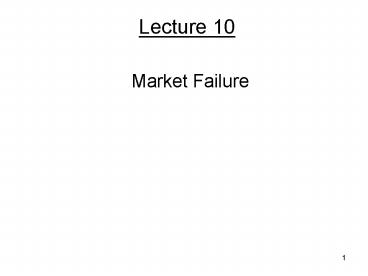Market Failure - PowerPoint PPT Presentation
1 / 22
Title: Market Failure
1
Lecture 10
- Market Failure
2
In a market
- Demand characterizes
- individual consumers behavior
- personal (private) evaluation of the outputs
worth - the benefits consumers receive from consuming the
good
- Supply characterizes
- individual producers behavior
- firms (private) evaluation of the resources used
in production - the cost of producing the good
3
In a market equilibrium
4
MB MC can be a market success because
value of last (marginal) unit of output
produced value of resources used to produce it
5
MB MC can be a market failure
market failure the private market produces an
outcome that is not best when considered from
societys viewpoint.
- Market failure
- happens when private market evaluation of costs
or benefits differ from society's evaluation - results in a misallocation of resources
- occurs when there are externalities
6
Externality cost or benefit of a private market
activity that spills-over onto a third party.
Positive Externality
7
- The private market allocates too few resources to
the production of the good.
8
- Internalize by
- the socially efficient quantity of output (Qs)
is produced - consumers pay a lower price
- since the subsidy is paid via taxation, society
pays part of the cost of production because
society enjoys some of the benefits.
9
- Sometimes the external benefit is so great the
product or service is made available for free.
- Society pays the entire cost because the benefit
is so significant. - Providing the product or service free maximizes
consumption.
10
- Negative Externality
- a cost spills over from a consumption or
production activity. - the private market supply (MC) understates the
cost to society (MCS)
11
- The private market allocates too many resources
to the production of the good.
12
- Internalize by
- taxing consumption or production
- the socially efficient quantity of output (Qs)
is produced - consumers pay a higher price
- taxation is a method of pricing the externality
13
Controlling Pollution
14
Pricing Pollution Who benefits from
pollution? MBpollution Who bears the costs
of pollution? MCpollution
15
- Conclusions
- The price (P) at which MBpollution MCpollution
is the size of the tax needed to internalize the
externality. - Often, the optimal level of pollution (Q) is not
zero.
16
- Conclusions
- In some instances, the optimal level of pollution
is zero.
17
Coase Rule Assigning property rights to the
environment results in a level of pollution
that is optimal.
Assign rights to non-polluters
Assign rights to polluters
18
Public Good products and services that are
consumed jointly
- Characteristics of public goods
- Consumption of the good by one party does not
reduce the availability to others. - No effective way to restrict the benefits to
those who directly pay for the good. - The market fails because societys benefit (MBS)
far exceed the cost of production (MC). - The government produces most public goods because
i.e., society pays the entire cost because the
benefit is so significant.
19
Joint consumption means the market demand is the
vertically sum of all individuals demand.
20
Under certain circumstances the private market
will produce some public goods but fails to
produce the socially efficient quantity .
21
In most circumstances the private market fails to
produce any public goods and government
production is necessary to achieve the socially
efficient quantity .
22
EOP Assignment
- Explain why the market outcome of MBMC is an
efficient allocation of resources. - What is market failure?
- What is an externality?
- What is the reasoning behind subsidizing a
product or service that creates a positive
externality? - What is the reasoning behind taxing a product or
service that creates a negative externality? - What is a public good?
- Why does the government produce most public goods?































